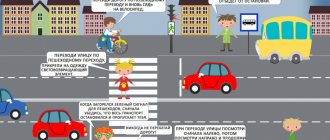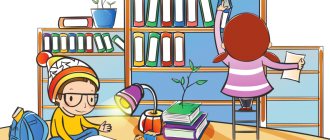Experience in traffic rules
In the older group, ideas are clarified and supplemented. During excursions and walks, teachers reinforced ideas about the roadway. They were introduced to the intersection and road signs (“Pedestrian crossing”, “Crossroads”, “Food station”, “Telephone”, “Parking area”, “Medical aid station”). Children received more complete knowledge of the rules for pedestrians and passengers. traffic rules through games, activities, walks and excursions, as well as on their own playground.
The group has a lot of board games that are made by the children together with the teacher. In games and entertainment, children easily and quickly remember things that may seem boring and uninteresting to them. To increase interest in the traffic alphabet , the following competitions, quizzes, competitions, entertainment “Safe Wheel”, leisure activity “Red, Yellow and Green”, KVN “ABC of Streets and Roads ” were held for children in this group. A lot of fiction is used in class and in free time: reading O. Tarutin’s book “Why do we need a traffic light?”, an excerpt from Dorokhov’s “Green, Yellow, Red”, Mikhalkov’s poem “My Street”, etc.
work with children 6-7 years old to familiarize themselves with the rules of the road so that the knowledge gained in classes, excursions, walks becomes durable and can be successfully applied by future schoolchildren.
all the material for working with children into groups.
The first group included didactic games “Recognize the sign”, “Paired pictures”, “Fold the sign”, “Make a picture”, etc. In my work I often
We use verbal methods, play verbal games: “Listen, remember”, “This is me, this is me, these are all my friends”, “Find out the sign by the riddle”.
The second group is games for the development of logical thinking: crosswords, mazes, puzzles, which contribute to the formation of children’s intellectual activity.
The third group is board-printed games “Who is an excellent pedestrian”, “Traffic light”, “How Pinocchio learned to walk”, “Loto”, “Dominoes”, etc. We use them to clarify and consolidate children’s knowledge of traffic rules .
The fourth group combined materials on modern non-standard games “Field of Miracles”, “What? Where? When?”, “A happy accident.”
The fifth group contains signs and a series of posters: “Teach to anticipate danger ”, “ Road certificate ”, etc.
In the sixth group, we combined materials to help educators and parents. These are notes from classes, entertainment, consultations, reports, moving folders.
The work of teaching children “ Road literacy ” is carried out not only in the classroom, but also in everyday life. To consolidate the knowledge gained in classes and games, we organize excursions and walks to the traffic lights, to the traffic police security room. Here, children learn directly in practice how to cross the street, how works and at which traffic light signal they are allowed to cross the road , and consolidate their knowledge of the rules for pedestrians and passengers. Senior preschoolers actively participate in the work of the “Young Traffic Inspectors” (“YID”) propaganda team : they show theatrical performances , skits, learn songs, poems, proverbs, and take part in the development and implementation of various educational programs.
The relevance of teaching children traffic rules and safe behavior on the roads
Huaco Mariet Azamatovna
The relevance of teaching children traffic rules and safe behavior on the roads
The topic of my speech today: “ The relevance of teaching children traffic rules and safe behavior on the roads ”
Let's start with the most important word in my topic. Relevance… . According to the modern encyclopedia, this word comes from the late Latin actualis - which means actually existing, present, modern, importance, significance of something for the present moment, topicality. At the present stage, at present, no one doubts the relevance of teaching children This is due to the fact that children do not have that defensive reaction to the road situation that is characteristic of us adults, coordination of movements .
The baby got to his feet - he is already a pedestrian. A child gets on a bicycle - he is already a driver. I went on the bus - he was already a passenger. And danger awaits him everywhere.
“Life is a gift, a great gift, and those who do not appreciate it do not deserve this gift,” Leonardo da Vinci once said. This responsibility must also be instilled in children, because it is known that most young pedestrians get into trouble on the road not because of ignorance of the rules of the road , but because of their childish naivety, inexperience, body characteristics, and because of thoughtless risks.
traffic accidents involving children and teenagers occur on roads . the roads especially worsens during the summer holidays. Knowing and following traffic rules will help shape children's safe behavior on the roads . Introducing a child to safe behavior on the road should be systematic and consistent.
Child injury due to non-compliance with traffic rules remains one of the most painful problems of our time. And children are the most valuable and precious thing in every person’s life.
The thirst for knowledge, the desire to discover something new, puts our little ones in front of real danger, in particular, on the street. That is why, already in kindergarten, it is necessary to study traffic rules with pupils, to develop in them the skills of conscious safe behavior .
For several years now (almost 10 years)
My practice of organizing the educational process within the framework of the cognitive and speech development of a preschool child includes the work of the
“Young Pedestrian”
.
A program on the basics of life safety for children , aimed at developing in a child the skills of correct behavior in non-standard and sometimes dangerous situations on the roads and in transport.
It has long been proven that every child from birth is endowed with enormous mental potential, which, under favorable conditions, develops effectively and enables the child to reach great heights in his development. It is equally important that the child develops harmoniously. And for this you need to develop skills for safe behavior on the road , expand children’s knowledge about transport , comply with the requirements of road signs , develop thinking and attention.
road safety teacher who has this knowledge. He helps with ideas, consultations, recommendations for teaching children how to behave safely on the road , methodological literature, and reflective attributes for children . Consolidating children's about traffic lights and the rules of safe behavior on the road , my students participate in many competitions and promotions of the State Traffic Safety Inspectorate of the Ministry of Internal Affairs of Russia "Adygei"
.
We expand children's knowledge about the rules of behavior on the road and on the sidewalk ; ideas about the purpose of road signs . We play role-playing games that solve problem situations according to traffic rules on the children's transport site - and this has become a favorite activity for our students.
I form the skill of navigating by traffic lights, I cultivate the need for children to be disciplined and attentive on the streets, cautious and prudent. After all, even Victor Hugo said: “... Teach , and you will give the world a person.”
I instill in children a culture of behavior on the road , a sense of respect for the work of a traffic police inspector, and the ability to apply the acquired knowledge in real life.
A necessary condition for the success of our work to develop safe behavior skills on the road is the cooperation of the kindergarten with the traffic police. Meetings with inspectors have become traditional. Our pupils enjoy communicating and discussing traffic problems with the inspector assigned to the kindergarten. the traffic safety promotion inspector Yana Olegova Sokolova. She is a frequent guest and assistant at our institution.
Today we can say that ensuring traffic safety on the road is becoming an increasingly important national task, especially since reports of road traffic accidents involving children cause great concern and concern to society.
“A teacher is a magician who opens
children's door to the world of adults. And what and how he will teach his pupils depends on what the teacher knows and can do.” So let’s open the door to this world carefully—keeping their children’s hearts.
Project on traffic regulations “Children and the Road”
Appendix 2
Conversation “Rules for pedestrians and passengers.”
Target:
familiarizing children with the rules for pedestrians and passengers.
Objectives:
- to reinforce with children the concepts of “driver” and “pedestrian”;
- develop children’s horizons and logical thinking, memory, reasoning, speech; - continue to develop a sense of responsibility for your life. Progress of the conversation:
Educator: Children, I want to start our conversation with the proverb: “Beware of troubles while they are not there.”
What do you think the proverb says? (children's answers) Children, what does the word “rules” mean? Can any of you explain to me? (children's answers) Educator: There are rules in the games that we play with you on a walk. There are rules of conduct in the theatre, cinema, and hospital. What other rules can you remember? (children's answers). Educator: I know that there are rules in every family. Maybe you can tell us about the rules in your family? (children's answers) Educator: Rules are a certain order. This means that the important thing for all these rules is that they must be followed. And today we will get acquainted with new rules for you. These rules will help you save life on the roads of our city. And these rules are called rules for pedestrians. There are also rules for drivers. And if drivers and pedestrians strictly follow their rules, then there will be no accidents. And when you grow up, you will learn the rules for drivers yourself in order to drive your own car or work as a driver. Pedestrian rules: Pedestrians must walk on the sidewalk or walkways. If they are absent - along the side of the road, towards moving traffic. When driving along the side of the road or the edge of a road in the dark, you must have objects with reflective elements with you. (the teacher shows children's clothes and objects with these effects). If there is no crossing or crossing in sight, you can cross the road at right angles to the side of the road where it is clearly visible. You cannot cross the road when entering it because of vehicles standing on it. You must cross the road quickly, without stopping on it. If you do not have time to cross a two-way road, you must stop at the dividing line and wait for a safe moment to cross further, if the traffic is not regulated by a traffic light or a traffic controller. Pedestrians are required to give way to special vehicles. (ambulance, police) It is necessary to cross the roadway using a pedestrian crossing (underground and overground). If they are absent, at intersections along the sidewalks or roadsides. Physical education
The guard stands stubborn (Walking in place).
He waves to people: Don't go! (Move your arms to the sides, up, to the sides, down) Here the cars drive straight (Hands in front of you) Pedestrian, you wait! (Hands to the sides) Look: he smiled, (Hands on his belt, smile) Invites us to go. (We walk in place) You cars, don’t rush, (Clapping hands) Let the pedestrian pass! (Jumping in place) Passenger rules
If there are seat belts in a vehicle, they must always be fastened.
When riding a motorcycle, you must wear a motorcycle helmet and fasten it. Wait for public transport at special stops. If they are not there, then on the sidewalk or curb. Passengers are prohibited from: Opening vehicle doors while driving. Drive a truck along with cargo. Talk to the driver while the vehicle is moving. Don't distract the driver! For an accident, a moment is enough. Remember, friends, you cannot distract the driver from driving. Educator: Now we’ll play with you. Game "Fast Drivers".
A typewriter is tied to a medium-length rope at one end and a pencil at the other. Team members need to wind a rope with a machine around a pencil as quickly as possible. Educator: Our journey to the country of traffic rules has ended. You have proven yourself to be competent, knowledgeable pedestrians. And I would like to remind you guys once again: Be careful all the time, And remember in advance: The driver and the pedestrian have their own rules.


